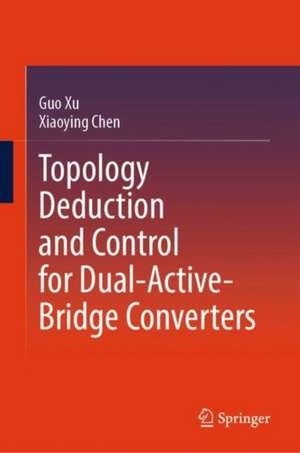Topology Deduction and Control for Dual-Active-Bridge Converters
Autor Guo Xu, Xiaoying Chenen Limba Engleză Hardback – 15 sep 2024
Preț: 1009.70 lei
Preț vechi: 1231.35 lei
-18% Nou
Puncte Express: 1515
Preț estimativ în valută:
193.21€ • 202.65$ • 160.84£
193.21€ • 202.65$ • 160.84£
Carte disponibilă
Livrare economică 11-25 martie
Preluare comenzi: 021 569.72.76
Specificații
ISBN-13: 9789819748556
ISBN-10: 9819748550
Pagini: 300
Ilustrații: Approx. 300 p. 40 illus.
Dimensiuni: 155 x 235 x 23 mm
Greutate: 0.73 kg
Ediția:2024
Editura: Springer Nature Singapore
Colecția Springer
Locul publicării:Singapore, Singapore
ISBN-10: 9819748550
Pagini: 300
Ilustrații: Approx. 300 p. 40 illus.
Dimensiuni: 155 x 235 x 23 mm
Greutate: 0.73 kg
Ediția:2024
Editura: Springer Nature Singapore
Colecția Springer
Locul publicării:Singapore, Singapore
Cuprins
Chapter 1 Introduction to Topology Deduction of Dual-Active-Bridge Converters.- Chapter 2 Design Considerations for Plus-Phase-Shift Controlled Current-Fed DAB Converter.- Chapter 3 Dead-time Optimization and Magnetizing Current Design for a Current-fed Dual Active Bridge DC-DC Converter.- Chapter 4 Hybrid-Bridge-Based DAB Converter with Modified Voltage Matching Control and Inductor Current Injections.- Chapter 5 Three-Winding-Coupled-Inductor-Based Dual Active Bridge DC-DC Converter with Full Load Range ZVS Under Wide Voltage Range.- Chapter 6 Modulated Coupled Inductor Based ISOP Dual-Active-Bridge Converter with Hybrid SPS Control.- Chapter 7 Magnetizing Current Injection based Push-Pull Dual Active Bridge Converter with Optimized Control.- Chapter 8 Light-load Efficiency Enhancement of High-Frequency Dual-Active-Bridge Converter Under SPS Control.- Chapter 9 Optimized EPS Control to Achieve Full Load Range ZVS with Seamless Transition for Dual Active Bridge Converters.-Chapter 10 An Optimized DPS Control for Dual Active Bridge Converters to Secure Full Load Range ZVS with Low Current Stress.- Chapter 11 Single-stage DAB-LLC Hybrid Bidirectional Converter with Tight Voltage Regulation under DCX Operation.- Chapter 12 An LLC-DAB Bidirectional DCX Converter with Wide Load Range ZVS and Reduced Switch Count.- Chapter 13 Stability Analysis and Design of Common Phase Shift Control for Input Series Output Parallel Dual Active Bridge with Consideration of Dead-time Effect.
Notă biografică
Guo Xu, Ph.D., is IEEE Senior Member, Associate Professor, and Deputy Director of Electrical Engineering Department in School of Automation, Central South University. He received B.S. degree in electrical engineering and automation and Ph.D. degree from the Beijing Institute of Technology, Beijing, China, in 2012 and 2018, respectively. He was funded by the China Scholarship Council and spent three months of short-term exchange at the University of Toronto, Canada, in 2012. From 2016 to 2017, he was Visiting Scholar at the Center for Power Electronics System, Virginia Polytechnic Institute and State University, Blacksburg, VA, USA, and the co-supervisor was Professor Fred C. Lee. Since 2018, he has been at the School of Automation, Central South University, Changsha, China, where he is currently Associate Professor. His research interests include modeling and control of power electronics converters, high-efficiency power conversion, and magnetic integration in power converters.
Xiaoying Chen received the B.S. degree and the Ph.D. degree from Central South University, Changsha, China, in 2017. He is currently Lecturer at the College of Electrical Engineering and Automation, Fuzhou University. His research interests include modeling and control of power electronics converters and high-efficiency power conversion. He has published 12 academic journal/conference papers.
Xiaoying Chen received the B.S. degree and the Ph.D. degree from Central South University, Changsha, China, in 2017. He is currently Lecturer at the College of Electrical Engineering and Automation, Fuzhou University. His research interests include modeling and control of power electronics converters and high-efficiency power conversion. He has published 12 academic journal/conference papers.
Textul de pe ultima copertă
This book provides a comprehensive review and classification for dual active bridge DC-DC converters. Based on the unified topology architecture of the dual active bridge DC-DC converters, the topologies derivation law is studied and new converter topologies are deducted correspondingly. Several novel converters are provided to illustrate different topology modification methods, including modified IO types, modified active bridges, modified transformers, adding auxiliary high-frequency networks, and modular topology structure. Meanwhile, the control optimization and the parameter design of the novel converters are also investigated.
Caracteristici
Provides an unified architecture and classification of popular bidirectional DC-DC converters Shares solutions on how to derive a novel feasible dual active bridge DC-DC topology Outlines the process for initiating the analysis of a new topology
